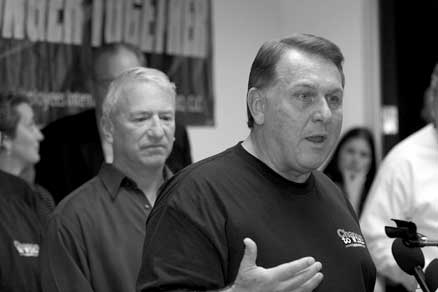
AFL-CIO President John Sweeney at the federation's convention in July. Photograph by Jim West.

Teamsters President James Hoffa at a July 25 press conference to announce disaffiliation from the AFL-CIO; SEIU President Andy Stern is at left. Photograph by Jim West.
No doubt this July's decision by the leadership of the Service Employees International Union and the Teamsters to walk out of the AFL-CIO and form an alternative labor federation, Change to Win, underlines the severe problems the U.S. labor movement faces today and the absence of clear answers as to how to move forward. But what does the split really mean? Can either side legitimately claim the support of progressive labor activists? How new is Change to Win's program--and what are its likely results? We invited a number of longtime labor activists and scholars to help sort it all out.
- A Split That May Mean More Labor UnityNathan Newman
- "New Politics" Not on the CTW AgendaSteve Early
- Did Anybody Say Working Class Power?Bill Fletcher, Jr.
- Labor's Dubious Distinction AwardsLeon Fink
- Spin to Win: Missed OpportunitiesRose Ann DeMoro
- A Real Alternative-Grassroots OrganizingImmanuel Ness
Issue # 261, September/October 2005
